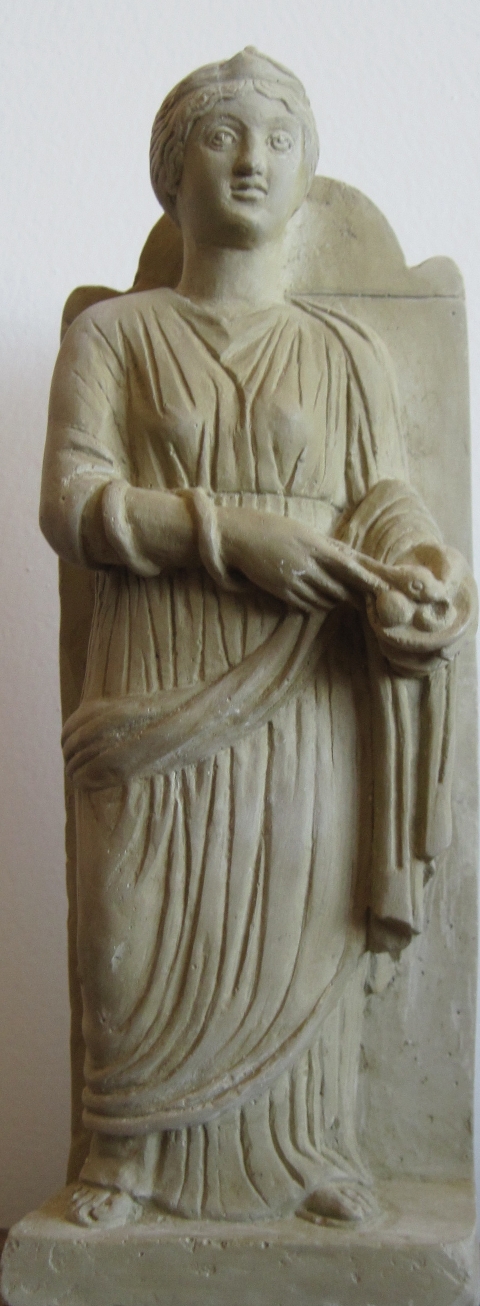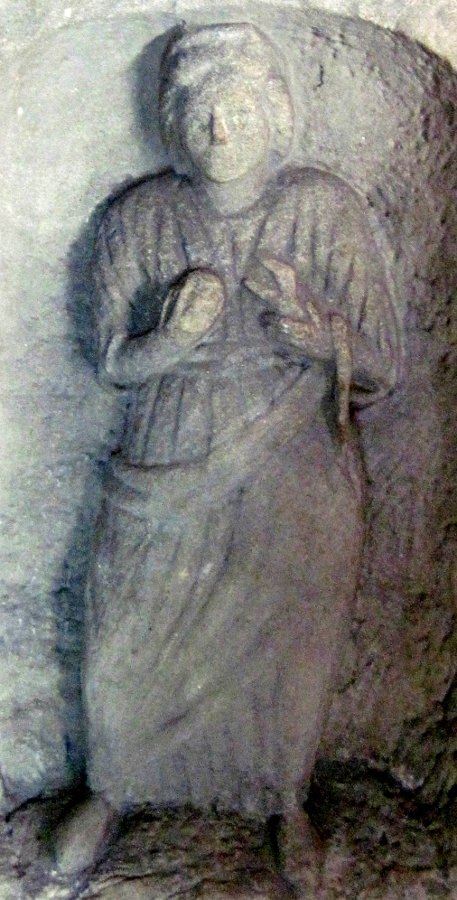


We often find the Gauls honouring a Roman god alongside a Celtic goddess. Ordinarily the latter’s role is complementary to that of the god, like Shakti’s is to Shiva. Though scholars frequently describe such goddesses as ‘consorts’ of the gods in question, such deities are not necessarily spouses or lovers (the Greek term paredros covers this ambiguity more exactly). At the same time, the Celtic partner can also have her own role and iconography. Such is the case with Ðirona or Sirona,[1] a goddess who accompanies Apollo in many depictions and inscriptions.
Ðirona is chiefly known in northern, central and eastern Gaul—a region of which she is one of the most characteristic goddesses. The contexts of her artifacts stress her role as one who heals through hot springs, and link Ðirona with Apollo Grannus in particular. At the same time, most invocations are addressed to “Apollo and Ðirona” without mentioning a Celtic epithet for the god, as though the goddess on her own ‘represents’ the conquered Celts, as it were. (The same is true of Mercury and Rosmerta; alone, the god often has a Gaulish name, but hardly ever when Rosmerta accompanies him.) The cult of Ðirona extended into the Danubian lands from Rhætia to Sarmizegetusa in the present-day district of Hunedoara in Romania. Apollo and Serana (sic) were even the patrons of the hot springs at Aquincum, the embryo of today’s city of Budapest. Like Rosmerta, Ðirona was more than just a female echo of her partner god; rather, she was worshipped on her own as well, as a dozen or so inscriptions demonstrate.[2a]
Ðirona’s iconography links her with the Greek goddess Hygieia and her Roman counterpart Salus. Her associated animal is therefore the serpent, symbol of regeneration as well as of healing (compare Hygieia’s cup, still the symbol of pharmacy, as well as the staff of Æsculapius, emblem of doctors, which both prominently feature snakes). Ðirona can often be seen feeding the snake with eggs from her patera. She normally wears a diadem and wears a long robe. The diadem—not a universal ornament among the Romans and Gauls—underscores her stellar aspect, on which we shall say more presently. The serpent and patera both figure as part of Hygieia’s standard iconography,[3] but we also see Ðirona with a cornucopia (as at Vienne-en-Val), sheaves of wheat (as at Sainte-Fontaine), or fruits. Ðirona thus presides not only over healing, but also over growth—the good outcomes that follow from health. While she normally wears a dress and sometimes even a veil, the bronze statue at Mâlain depicts Thiron(a) (sic) semi-nude with a serpent on her arm.[4] A Mediomatrican monument from Saint-Avold depicts only a bust, and then in a strikingly stylized manner, one might almost say, of Egyptian inspiration.
Sanctuaries at springs drew large numbers of pilgrims who came there to spend the night and hear the god’s prescriptions in their dreams. These sanctuaries thus became “social centres par excellence”, with inns, shops and above all theatres. As Apollo is, with Bacchus, one of the patrons of drama, it was only fitting to watch plays in his sanctuaries.[5]
The goddess’s name is of interest for several reasons. First, we should explain the intial letter, which we have written as Ð but can also appear in the texts as Θ, TH, S or (the commonest variant of all) S. This shape-shifting letter, which Virgil calls the “tau
gallicum”,[6] is in reality a local adaptation of the Greek theta for the Roman alphabet as used for Gaulish (this is why we have placed Ð, like theta, between H and I in alphabetic order). The horizontal bar should actually extend nearly from one side to the other within the D, as it does in theta. How the tau gallicum was pronounced is a matter of debate. Etymologically, it is related to Proto-Indo-European *st and *ts, but it is represented by a letter that in ancient Greek was pronounced as [th]. The pronunciation [ts] is the one most often suggested, but we can hardly exclude such possibilities as [tθ] or [θ]. While the spelling
Sirona is the most common, we prefer the variant Ðirona to indicate that this is, in any case, not a normal [s] sound.
The same augmentative suffix -on- can be recognized in ‘Ðirona’ as in so many other theonyms (Epona, Maponos, Matrona, Ritona, etc.). The root ðīr- is related to the Welsh sêr (‘stars’);[7] the name Ðirona therefore means the ‘Great Star’. The variant Serona is thought to preserve the archaic form ðēr-. This shows how Ðirona’s role complements that of Apollo: just as the god has a significant solar aspect in Gaul, his companion reveals her stellar side. An inscription at Augsburg in the province of Rhætia invokes “Apollo Grannus, Diana and holy Sirona”, thus bringing together deities of the sun, moon and stars.[8]
It’s worth mentioning that the identification of Ðirona with the star is essentially based on etymology, rather than iconography or other written evidence. But before leaving the issue of an astral Ðirona, let us explore the question of which star might have been, in the eyes of the Celts, the ‘Great One’. Here is a run-down of a few possibilities, however uncertain and non-exhaustive they might be. We’re looking for a bright, noticeable star, preferably with some mythological links to Hygieia or the serpent.
A few other possibilities will be brought up during our discussion of Damona below.

“Bright-eyed mother, highest queen of Apollon's golden throne, desirable, gently-laughing Hygeia (Health).”
— Licymnius[9]
We have already mentioned Hygieia, who provides a kind of template for the Gaulish Ðirona. Her Latin counterpart is normally Salus, the personification of well-being. The word salús is frequently found on ex-votos: ‘to such-and-such deity, such a person prays for the well-being (pró salútí) of someone else’. Whether we conceive of Salus as a separate deity or as a state of life, the word covers a wide variety of meanings in Latin: health, general well-being, salvation.
It is possible to interpret one deity in terms of another, without confounding the two. Harriet Beecher Stowe identifies the character of Uncle Tom with Jesus Christ, but she clearly was able to distinguish between them at need. The Gauls certainly represented Ðirona as Hygieia, and they must have called her Salus from time to time for the Romans to understand them (this is notably the case for the Emperor’s Own Regiment of Horse at Rome, an élite cavalry unit recruited in large part from Gaul). Still, this by no means that the identities of the various deities were altogether lost in each other.
There is an area of Gaul, roughly corresponding to the provinces of Lugdunensis Prima and Lugdunensis Senonia, where Ðirona is virtually unknown. In her stead we find the goddess Damona, who is also depicted with a serpent, sheaf of wheat and sometimes a patera. Such attributes imply that she shared Ðirona’s patronage of prosperity-giving wholesomeness. Damona’s partner is called either Borvo (at Bourbon-Lancy and Bourbonne-les-Bains) or Apollo Moritasgus (at Alesia), or even the god Albius (otherwise unknown, at Arnay-le-Duc). Among their worshippers are many who, to judge from their names, would have been Gauls of sufficiently high standing to have become Roman citizens.[2b]
One probable member of this class, Julia Malla of Saintes, even made a dedication in memory of her daughter to the numens of the Augusti and to the goddess Damona Maturberginis. The invocation of the Emperors and the rank of the dedicant underscore the goddess’s importance, at least for Julia Malla; but the procedure of making a dedication to the memory of a deceased person is unusual, as also is the epithet Matuberginis.[11]
The name Damona may surprise us, since it is to be translated as ‘the Great Cow’—evidently a kinder-sounding appellation in Gaulish than it is in English.[12] This sort of name finds a parallel in Epona, goddess of horsemen whose name means “the Great Mare”.[13] Suppose, then, that the ‘great star’ of Ðirona was also called ‘the Cow’? Shall we then place it in the constellation of Taurus (perhaps among the Pleiades, which can be recognized on the Nebra disk,[14] a Bronze Age astronomical artifact), or among the stars of Cancer that correspond to the nakshatra of Pushya (symbol of the cow in Indian astrology[15])?
Two inscriptions invoke another goddess, Bormana, who must also be related to Damona. One, on an altar at Aix-en-Diois in the département of the Drôme, invokes Bormanus and Bormana (the first of which should be a local form of Borvo who is also present at Aix-en-Provence). The other inscription, at Saint-Vulbas in the département of the Ain, invokes Bormana Augusta on her own.[17]
Ðirona is a goddess who presides over not only healing but the flourishing that health can bring. Preventive care is her domain, as is the idea of overall well-being that belongs to the word salús. Along with the great Apollo, her partner, she is the proprietor of many hot springs with a reputation for healing powers, such as those of Grand and Budapest. Also like Apollo, she would appear in patients’ dreams to reveal what they should do to recuperate. Her name and her diadem lead us to consider her an astral goddess, a kind of night-time projection of the brilliance of the solar Apollo.
The name and sites of Damona/Bormana allow us to add additional nuances to this portrait, but it is hard to state that this was altogether a distinct deity. Their cults, in complementary distribution with Ðirona’s, lead us rather to believe Damona to have been the avatar, not the rival, of Ðirona in the Senonian region.

